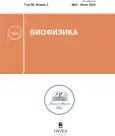УНИКАЛЬНЫЕ ОСОБЕННОСТИ ЛЮМИНЕСЦЕНТНОГО ГРИБА Mycena gombakensis
- Авторы: Пузырь А.П1, Посохина Е.Д1, Тимофеев А.А2,3, Буров А.Е1,4, Медведева С.Е1, Павлов И.Н2,5
-
Учреждения:
- Институт биофизики СО РАН – обособленное подразделение ФИЦ «Красноярский научный центр Сибирского отделения РАН»
- Институт леса СО РАН – обособленное подразделение ФИЦ «Красноярский научный центр Сибирского отделения РАН»
- Лаборатория геномных исследований и биотехнологии ФИЦ «Красноярский научный центр Сибирского отделения РАН»
- Федеральный исследовательский центр информационных и вычислительных технологий
- Сибирский государственный университет науки и технологий имени академика М.Ф. Решетнева
- Выпуск: Том 69, № 3 (2024)
- Страницы: 594-602
- Раздел: Биофизика клетки
- URL: https://journals.rcsi.science/0006-3029/article/view/262932
- DOI: https://doi.org/10.31857/S0006302924030154
- EDN: https://elibrary.ru/OEUFUW
- ID: 262932
Цитировать
Полный текст
Аннотация
Ключевые слова
Об авторах
А. П Пузырь
Институт биофизики СО РАН – обособленное подразделение ФИЦ «Красноярский научный центр Сибирского отделения РАН»
Email: apuzyr@mail.ru
Красноярск, Россия
Е. Д Посохина
Институт биофизики СО РАН – обособленное подразделение ФИЦ «Красноярский научный центр Сибирского отделения РАН»Красноярск, Россия
А. А Тимофеев
Институт леса СО РАН – обособленное подразделение ФИЦ «Красноярский научный центр Сибирского отделения РАН»; Лаборатория геномных исследований и биотехнологии ФИЦ «Красноярский научный центр Сибирского отделения РАН»Красноярск, Россия; Красноярск, Россия
А. Е Буров
Институт биофизики СО РАН – обособленное подразделение ФИЦ «Красноярский научный центр Сибирского отделения РАН»; Федеральный исследовательский центр информационных и вычислительных технологийКрасноярск, Россия; Новосибирск, Россия
С. Е Медведева
Институт биофизики СО РАН – обособленное подразделение ФИЦ «Красноярский научный центр Сибирского отделения РАН»Красноярск, Россия
И. Н Павлов
Институт леса СО РАН – обособленное подразделение ФИЦ «Красноярский научный центр Сибирского отделения РАН»; Сибирский государственный университет науки и технологий имени академика М.Ф. РешетневаКрасноярск, Россия; Красноярск, Россия
Список литературы
- Sabharwal S. C., Kathuria S. P., and Dhingra M. M. A new bioluminescent fungal system. J. Biosci., 5, 53–62 (1983). doi: 10.1007/BF02702593
- Deheyn D. D. and Latz M. I. Bioluminescence characteristics of a tropical terrestrial fungus (Basidiomycetes). Luminescence, 22 (5), 462–467 (2007). doi: 10.1002/bio.985
- Puzyr A. P., Medvedeva S. E., and Bondar V. S. The use of glowing wood as a source of luminescent culture of fungus mycelium. Mycosphere, 7 (1), 1–17 (2016). doi: 10.5943/mycosphere/7/1/1
- Puzyr A. P. and Medvedeva S. E. Luminescence of wood samples during long-term storage. Mycosphere, 7 (6), 716–727 (2016). doi: 10.5943/mycosphere/7/6/2
- Menkis A., Ihrmark K., Stenlid J., and Vasaitis R. Root-associated fungi of Rosa rugosa grown on the frontal dunes of the Baltic Sea Coast in Lithuania. Microb. Ecology, 67, 769–774 (2014). doi: 10.1007/s00248-013-0351-8
- Gardes M. and Bruns T. D. ITS Primers with enhanced specificity for basidiomycetes – application to the identification of mycorrhizae and rusts. Mol. Ecology, 2, 113–118 (1993). doi: 10.1111/j.1365294X.1993.tb00005.x
- White T. J., Bruns T., Lee S. B., and Taylor J. W. Amplification and direct sequencing of fungal ribosomal RNA genes for phylogenetics. In PCR protocols: a guide to methods and applications, Ed. by M. A. Innis, D. H. Gelfand, J. J. Sninsky and T. J. White (N.-Y., Acad. Press, 1990), pp. 315–322.
- Stielow J. B., Levesque C. A., Seifert K. A., Meyer W., Irinyi L., Smits D., Renfurm R., Verkley G. J. M., Groenewald M., Chaduli D., Lomascolo A., Welti S., Lesage-Meessen L., Favel A., Al-Hatmi A. M. S., Damm U., Yilmaz N., Houbraken J., Lombard L., Quaedvlieg W., Binder M., Vaas L. A. I., Vu D., Yurkov A., Begerow D., Roehl O., Guerreiro M., Fonseca A., Samerpitak K., van Diepeningen A. D., Dolatabadi S., Moreno L. F., Casaregola S., Mallet S., Jacques N., Roscini L., Egidi E., Bizet C., Garcia-Hermoso D., Martin M. P., Deng S., Groenewald J. Z., Boekhout T., de Beer Z. W., Barnes I., Duong T. A., Wingfield M. J., de Hoog G. S., Crous P. W., Lewis C.T., Hambleton S., Moussa T. A. A., Al-Zahrani H. S., Almaghrabi O. A., Louis-Seize G., Assabgui R., McCormick W., Omer G., Dukik K., Cardinali G., Eberhardt U., de Vries M., and Robert V. One fungus, which genes? Development and assessment of universal primers for potential secondary fungal DNA barcodes. Persoonia, 35 (1), 242–263 (2015). doi: 10.3767/003158515X689135
- Kumar S., Stecher G., Li M., Knyaz C., and Tamura K. MEGA X: Molecular evolutionary genetics analysis across computing platforms. Mol. Biol. Evolution, 35 (6), 1547–1549 (2018). doi: 10.1093/molbev/msy096
- Tajima F. and Nei M. Estimation of evolutionary distance between nucleotide sequences. Mol. Biol. Evolution, 1 (3), 269–285 (1984). doi: 10.1093/oxfordjournals.molbev.a040317
- Chew A. L. C., Desjardin D. E., Tan Y. S., Musa M. Y., and Sabaratnam V. Bioluminescent fungi from Peninsular Malaysia. Fungal Diversity, 70, 149–187 (2014). doi: 10.1007/s13225-014-0302-9
- Oliveira A. G., Stevani C. V., Waldenmaier H. E., Viviani V., Emerson J. M., Loros J. J., and Dunlap J. C. Circadian control sheds light on fungal bioluminescence. Curr. Biol., 25 (7), 964–968 (2015). doi: 10.1016/j.cub.2015.02.021
Дополнительные файлы










